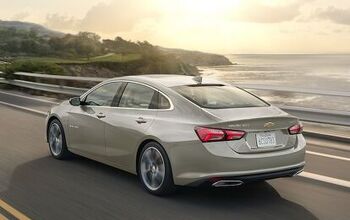QOTD: What So-called 'Special' Car Let You Down?

I was channel surfing over the weekend and stumbled upon 2002’s Die Another Day, the last entry in the Pierce Brosnan era of James Bond flicks. Arguably the worst of the four. I’m a GoldenEye man myself, in no small part due to the video game that was big among my social groups in high school and on into college.
Anyway, while watching Die for about the fifth time this month (hey, it’s on Showtime a lot, what can I say?), I took note of the scene in which Halle Barry’s character pulls up to the ice-palace hotel in Iceland in a Ford Thunderbird. One of those retro models sold from 2002-2005 that came out with much fanfare — it was even a Motor Trend Car of the Year — before sales fell off a cliff.
Thing is, I always thought that generation of T-Bird looked great. I still do. But it sold poorly after the first year.
That T-Bird was one in a long line of cars cranked out in the 1990s and the Aughts, mostly by the Detroit Three, that attempted to capture buyers based on retro styling but either was a let-down in terms of performance or simply wasn’t marketed well. In the T-Bird’s case, a quick Google shows that reviewers at the time praised its looks but dished out mixed feelings about its performance. They seemed to like the V8 and dislike the five-speed automatic, and were upset by shakes and rattles. The consensus seems to be that the car would sell well and be thought of as a boulevard cruiser and not a sports car.
Other cars on the list of “hyped then, looked back upon with wary eyes now” include the Plymouth Prowler, Chrysler PT Cruiser, Chrysler Crossfire, Chevrolet SSR, and Chevrolet HHR (non-SS).
There were other models that attempted to snag sales, not with retro looks but modernist styling, that also flopped like a just-caught marlin – think Cadillac XLR.
What car were you once hyped about, only to later learn it wasn’t all it was cracked up to be?
Maybe you test-drove one of these vehicles and found out the hard way? Or you bought one in a fit of temporary madness? Perhaps you had extensive seat time for some reason – someone else in your household had one and you drove it on occasion, or you worked for a dealer that sold these abominations and you had to drive one every now and then? Maybe, like me, you spent a month in one that the rental-car company foisted upon you while your Accord sat lonely in a body shop waiting on parts after being smacked by a Saab wagon that went wild due to black ice?
Yes, friends, I “owned” a PT Cruiser for about a month while my poor Honda awaited the surgeon’s touch.
This question has been on my mind not just because I saw a T-Bird in an 18-year-old movie, but also because the upcoming Bronco could disappoint. I don’t think it will, based on its specs and Adam’s first-ride report, but we won’t know for a while yet. Hopefully, the return of the Bronco goes over better than the return of the Thunderbird.
Until then, I want to know what car got you all hot and bothered, only to find out that it was the automotive equivalent of a cold shower?
[Image: Steve Lagreca / Shutterstock.com]

Tim Healey grew up around the auto-parts business and has always had a love for cars — his parents joke his first word was “‘Vette”. Despite this, he wanted to pursue a career in sports writing but he ended up falling semi-accidentally into the automotive-journalism industry, first at Consumer Guide Automotive and later at Web2Carz.com. He also worked as an industry analyst at Mintel Group and freelanced for About.com, CarFax, Vehix.com, High Gear Media, Torque News, FutureCar.com, Cars.com, among others, and of course Vertical Scope sites such as AutoGuide.com, Off-Road.com, and HybridCars.com. He’s an urbanite and as such, doesn’t need a daily driver, but if he had one, it would be compact, sporty, and have a manual transmission.
More by Tim Healey
Latest Car Reviews
Read moreLatest Product Reviews
Read moreRecent Comments
- Pau65792686 I think there is a need for more sedans. Some people would rather drive a car over SUV’s or CUV’s. If Honda and Toyota can do it why not American brands. We need more affordable sedans.
- Tassos Obsolete relic is NOT a used car.It might have attracted some buyers in ITS DAY, 1985, 40 years ago, but NOT today, unless you are a damned fool.
- Stan Reither Jr. Part throttle efficiency was mentioned earlier in a postThis type of reciprocating engine opens the door to achieve(slightly) variable stroke which would provide variable mechanical compression ratio adjustments for high vacuum (light load) or boost(power) conditions IMO
- Joe65688619 Keep in mind some of these suppliers are not just supplying parts, but assembled components (easy example is transmissions). But there are far more, and the more they are electronically connected and integrated with rest of the platform the more complex to design, engineer, and manufacture. Most contract manufacturers don't make a lot of money in the design and engineering space because their customers to that. Commodity components can be sourced anywhere, but there are only a handful of contract manufacturers (usually diversified companies that build all kinds of stuff for other brands) can engineer and build the more complex components, especially with electronics. Every single new car I've purchased in the last few years has had some sort of electronic component issue: Infinti (battery drain caused by software bug and poorly grounded wires), Acura (radio hiss, pops, burps, dash and infotainment screens occasionally throw errors and the ignition must be killed to reboot them, voice nav, whether using the car's system or CarPlay can't seem to make up its mind as to which speakers to use and how loud, even using the same app on the same trip - I almost jumped in my seat once), GMC drivetrain EMF causing a whine in the speakers that even when "off" that phased with engine RPM), Nissan (didn't have issues until 120K miles, but occassionally blew fuses for interior components - likely not a manufacturing defect other than a short developed somewhere, but on a high-mileage car that was mechanically sound was too expensive to fix (a lot of trial and error and tracing connections = labor costs). What I suspect will happen is that only the largest commodity suppliers that can really leverage their supply chain will remain, and for the more complex components (think bumper assemblies or the electronics for them supporting all kinds of sensors) will likley consolidate to a handful of manufacturers who may eventually specialize in what they produce. This is part of the reason why seemingly minor crashes cost so much - an auto brand does nst have the parts on hand to replace an integrated sensor , nor the expertice as they never built them, but bought them). And their suppliers, in attempt to cut costs, build them in way that is cheap to manufacture (not necessarily poorly bulit) but difficult to replace without swapping entire assemblies or units).I've love to see an article on repair costs and how those are impacting insurance rates. You almost need gap insurance now because of how quickly cars depreciate yet remain expensive to fix (orders more to originally build, in some cases). No way I would buy a CyberTruck - don't want one, but if I did, this would stop me. And it's not just EVs.
- Joe65688619 I agree there should be more sedans, but recognize the trend. There's still a market for performance oriented-drivers. IMHO a low budget sedan will always be outsold by a low budget SUV. But a sports sedan, or a well executed mid-level sedan (the Accord and Camry) work. Smaller market for large sedans except I think for an older population. What I'm hoping to see is some consolidation across brands - the TLX for example is not selling well, but if it was offered only in the up-level configurations it would not be competing with it's Honda sibling. I know that makes the market smaller and niche, but that was the original purpose of the "luxury" brands - badge-engineering an existing platform at a relatively lower cost than a different car and sell it with a higher margin for buyers willing and able to pay for them. Also creates some "brand cachet." But smart buyers know that simple badging and slightly better interiors are usually not worth the cost. Put the innovative tech in the higher-end brands first, differentiate they drivetrain so it's "better" (the RDX sells well for Acura, same motor and tranmission, added turbo which makes a notable difference compared to the CRV). The sedan in many Western European countries is the "family car" as opposed to micro and compact crossovers (which still sell big, but can usually seat no more than a compact sedan).


































Comments
Join the conversation
A few years back (on that _other_ site I think) I asked about the failed transmission in my buddy's PT Cruiser he'd bought new . He loved the car but was badly caught in the failing economy, (mostly his own stupidity truth be known) , he held onto it and now has a $3,500 rebuilt tranny and still loves it . I think the worst turd I ever polished was a 1962 VW #151 DeLuxe convertible we pulled out of a field, I used discarded speed limit signs to replace the gone missing (rusted out) floors and repainted it the original forest green, fell in love with the damned thing and kept it as a daily driver... _RUST_NEVER_SLEEPS_ plus it causes all manner of weirdness few Mechanics ever encounter, it's a wonder I have any hair left . -Nate
Had a friend who was with Microsoft at the peak time it was cool to be with them. I was going to buy his 1994 Accord Coupe because he was moving uptown to the BMW dealership. He took me along for the afternoon of test driving various permutations of 3-Series. I could not have bene more disappointed in the M3. I’d owned a 1978 Camaro and while it did have shocks and springs when you looked beneath, I can’t believe they had anything to do with the suspension or ride of that vehicle. Like the 1978 Camaro, the M3 rode as if the wheels were bolted directly to the car (though it DID corner better). Cost was no object for my friend (remember : Microsoft) but when asked for my opinion I favored the 328is with the sport package. “If I had to have that M3 as my daily driver I’d shoot myself” Although within 2 months he bought a boat. And than bought a Dodge Ram to pull it with, so maybe the M3 would’ve worked for him? But that Accord Coupe did not disappoint. Holy smoke that was a great car.